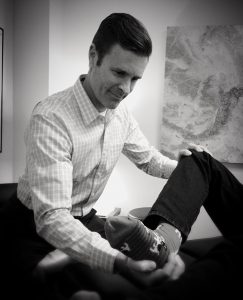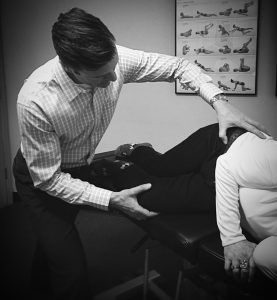I frequently have patients come in and tell me they have a herniated disc, arthritis in their knee, a worn out rotator cuff, etc. My question for them is, “Do you know WHY the disc herniation, arthritis, or rotator cuff problem has developed?” OR “Has your doctor, physical therapist or other chiropractor found what is causing your _________ to wear out?”
The way in which musculoskeletal conditions are evaluated and treated is less than adequate most of the time. Many practitioners simply examine the site of pain or symptom, perform a few cursory tests and put a name (diagnosis) on the condition. Treatment of the painful site follows in an effort to cover up symptoms. Treating the site of pain is often necessary (I do this as well) but more often than not, relief is only temporary because the underlying cause of the pain is not being addressed and a permanent solution is not being provided.
In order for us to find a permanent solution for your musculoskeletal problem, we have to find the underlying cause that is contributing to the problem.
- Is it due to an alignment problem of the spine?
- Are the core muscles not activating properly when you do normal, everyday movements?
- Do the hip joints “hinge” properly when you bend forward?
- Is a weak and unstable foot causing improper knee alignment when you walk or squat down to pick things up?
- Is there a weak connection between your core and shoulder that is causing your rotator cuff to wear out?
These are the types of questions for which I seek answers when I evaluate my patients. Once we find the answer, we can implement a solution.

Evaluation and Assessments
Patients often tell me after their evaluation,
“That is the most thorough exam I have ever had!”
The goal of every evaluation I perform is to not only find the source of pain or other symptoms, but also find the contributing factors that are causing the problem. In order to do this, we have to be thorough. We also have to take a full body approach to find the area that is driving the condition. Low back pain, for example, can be due to poor postural alignment of the upper body or it could be due to a movement dysfunction in the hip or foot. Hand and wrist conditions can be due to a neck or shoulder problem. All areas of the body need to be evaluated if we want to find a permanent solution for you condition.
Depending on your condition, examinations consist of any combination of the following:
- Alignment Assessment: Evaluating your posture and the alignment of your spine is very important because poor posture and abnormal spinal alignment is a known cause of spinal pain, disc problems extremity conditions, and neurological symptoms.
- Movement Assessment: Observing how you perform basic movements, such as walking, bending, and squatting can reveal movement “errors” that are contributing to your condition. It can also identify joints or other parts of the body that are weak or unstable.
- Orthopedic/Neurological Testing: This helps reveal the source of the pain, whether it is a coming from muscle, joint, disc, tendon, nerve, etc.
- Range of Motion: Testing the flexibility of your joints will identify if any of them are stiff, fixated, or hypermobile. Too much or not enough range of movement is a sign of an imbalance in the nervous system.
- Manual Muscle Testing: This is performed to determine if the brain is able to fully activate key muscles that are responsible for maintaining stable, properly aligned joints. Muscles that test “weak” are often a source of joint problems and pain.
- Soft Tissue/Muscle Tone Assessment: Palpating (feeling) muscle tone reveals neurological imbalances in the body. In a state of dysfunction, the brain will create too much tone (tightness/trigger points) in some muscles and not enough tone (weakness/inhibition) in other muscles.
Types of Treatment
The two primary treatment, exercise and rehabilitation methods I use are Chiropractic Biophysics(CBP) and Dynamic Neuromuscular Stabilization(DNS). CBP is the most advanced, researched method in the chiropractic profession. The goal of the CBP approach is to restore the alignment of the spinal column with corrective adjustments, exercises, and traction (if necessary). DNS is a relatively new, advanced treatment and exercise approach that reprograms the brain to improve posture, joint stabilization, and movement throughout the body.
Below is a more specific list of chiropractic adjusting and manual therapy methods I use, depending on the patient’s needs and treatment preferences:
- Drop Table Adjustments: Sections of the adjusting table go up and down during the adjustment to “reset” spinal alignment
- Instrument Adjusting: An instrument delivers a gentle “tapping” sensation to “reset” spinal alignment
- Traditional Chiropractic Manipulation: This is the type that makes the “popping” sound. Some people like it, some people don’t. I use it in areas where joints are fixated (stuck) to improve flexibility and I only perform this on patients that are comfortable with the procedure.
- PNF (Proprioceptive Neuromuscular Facilitation): This is performed to release tight, painful muscles and improve joint flexibility. It is a more gentle, less invasive alternative to joint manipulation.
- Muscle Reflex Techniques: Muscles that test weak during manual muscle testing can immediately be reactivated to full strength by utilizing the body’s built in reflexes.
- DNS: Patients are placed in developmental milestone positions to reboot the central nervous system to restore posture, stability and movement throughout the body.

These treatments make a difference that you can feel.
Immediately after treatment, patients often state:
“I feel like I am standing taller and not hunched over anymore.”
“My hips feel stronger and more stable.”
“I feel like I am walking lighter on my feet.”
“My entire body feels balanced again.”
In summary, my approach to evaluating musculoskeletal problems is to find the contributing factors that are actually causing the condition. By identifying and treating the underlying cause, patients get better faster and results often last longer compared to conventional chiropractic and medical treatment.